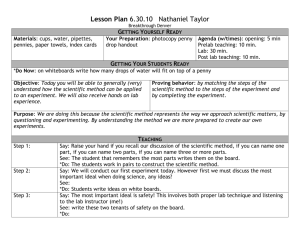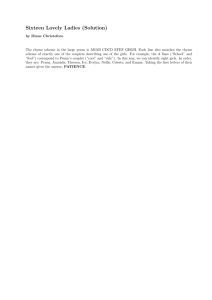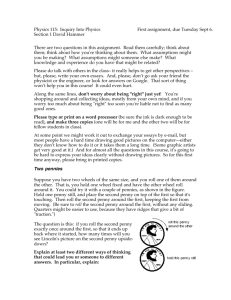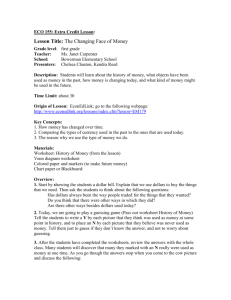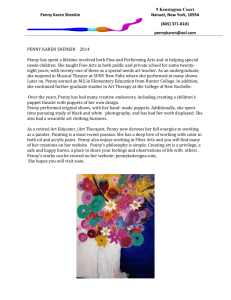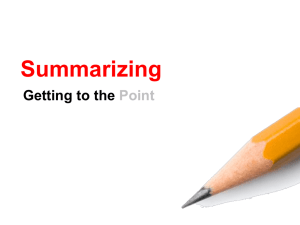PlayChem
advertisement
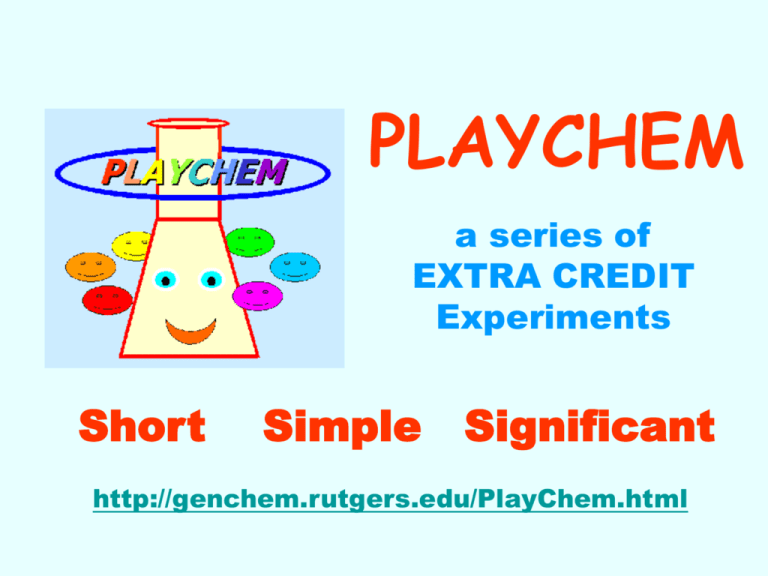
PLAYCHEM a series of EXTRA CREDIT Experiments Short Simple Significant http://genchem.rutgers.edu/PlayChem.html ABOUT the • • • • • • • • • • • PLAYCHEM EXPERIMENTS Experiment is individualized and run by computer. Experimental work takes 15-30 min. Calculations and conclusion take 15-30 min. Data and calculations entered into computer. Computer asks questions and grades student work. Experiments are turned in. Grades recorded using computer and student number. Requires little or no instructor time. Used as 20-25 pt EXTRA-CREDIT in Gen Chem Lab. Five PlayChem experiments per semester. 6% of total points in our course. Creating a PLAYCHEM Experiment 1. Steal an idea 2. 3. 4. 5. (J Chem Ed) Modify to taste Make it significant Computerize Try PLAYCHEM EXPERIMENTS 1. ALCHEMY 2. ASPIRIN 3. AVOGADRO 4. BISULFATE 5. BLACKPEN 4. BREATHALYZER 7. CALIBRATE 8. CANCRUSH 7. CANDLELIGHT 10. DENPEN 11. DOBJECT 10. HYFORM 13. ICE 14. IVY 13. MILK 16. MOLRAT 17. MONEYCAL 16. MONEYCULE 19. MONEYKIN 20. ORG 19. PARADOX 22. POLLUTION 23. POPCORN 22. POTENTIAL 25. PUTTY & SLIME 26. REACT 28. SODACAN 29. STEELWOOL 31. ZERO 32. ZINC IODIDE 25. SOAP 30. VINEGAR http://genchem.rutgers.edu/PlayChem.html SteelWool Burning SteelWool in air and in Oxygen Calculate % weight change Write chemical equation • • • • • • Weigh an assigned amount of Steel Wool. Burn in Air and observe. Weigh resulting residue. Generate oxygen. (2 H2O2 O2 + H 2 O) Repeat burning iron except in oxygen. What happened? Why the difference? MolRat Mohr Titration Ag+ + Cl2 Ag+ + CrO4-2 Drop-wise (Ag+ to Cl-) titration. AgCl Ag2CrO4 V x M = mmol Using 0.10, 0.20 and 0.30 M NaCl and AgNO3 solutions Assigning above solutions with “adjusted” concentrations creates combining stoichiometries of M3X M2X M3X2 MX M2X3 MX2 MX3 CanCrush Charles’ Law - Kinetics Vc/Tc = Vh/Th Density of water = 1.00 g/cc Pair remains constant (Ignore PH O) 2 Determine temperatures inside of soda cans. • • • • • • • • • One is dry, the other contains a few mL of water. Vh Weigh “dry can”. Heat both on a hot hot-plate until water boils. Insert both, mouth down into a room temp water bath. Vc Stopper opening of “dry can” and remove from bath. Weigh. Fill “dry can” with water and reweigh. Read room temperature. Determine temperature in each can. MoneyCules Mass of US Coins Nickel = 5.0 g Zinc and Brass Pennies Mass of Dimes and Quarters are related Plotting mass of coins vs dates • Average Atomic Weight for a penny (zinc and copper isotopes). • Counting value of “silver” coins by weighing. • Creating a molecular structure from a set of coins. • GREED Penny =1 Nickel = 2 Dime = 2 or 3 Quarter = 4 PUTTY and SLIME Molecular Structure – Polymers - Physical Properties • Partially hydrolyzed polyvinyl acetate • Guar Gum Polymer solutions are viscous • Compare weight % vs Molarity Crosslink with BORAX • Effects of long term stress • Effect of sudden stress • Reasons for the above Possible uses for products SOAP HARDNESS of WATER Previously carried out EDTA titration Dropwise titration of hard water using soap suds as the end point • • • • • Titrate equal amounts of two STANDARDS and an UNKNOWN. Use distilled water as the BLANK. Determine the average Titer, mg CaCO3/drop, of the soap. Calculate the hardness of the WATER UNKNOWN. Add a water softener and recheck hardness. ICE Heat of Fusion of DiHydrogen Monoxide DHMO • • • • • • Styrofoam cup calorimeter with magnetic stirring bar Computer assigned volume of hot water Computer assigned calorimeter constant Vernier LoggerPro© temperature probe Add “dried crystalline DHMO” Determine Heat of Fusion of DHMO BreathAlyzer 400 500 600 nm ABSORBANCE Chromate Cr(III) Student is given an alcohol STANDARD and a “Blood Sample”. Student must determine if Suspect is guilty of “Driving Under the Influence” BEER’S LAW WAVELENGTH 3 CH3CH2OH + 16 H+ + 2 Cr2O7-2 C1/A1 = C2/A2 3 CH3CO2H + 11 H2O + 4 Cr+3 • Alcohol is oxidized by acid dichromate in boiling water bath. • Concentration is determined by Cr(III) concentration. • Spectroscopy using Beer’s Law at 580 nm. DenPen Density of a Penny Mass Volume • Measure dimensions • Measure water displaced PLOTS • • • • Penny Mass vs Date Penny Mass vs Volume Penny Mass vs Number Circumference/Diameter Ratio Collects and displays multiple data. Particular useful for High School. ALCHEMY Turning a coppery U.S. cent into a silvery then a golden penny. • Heat a 1983+ penny in the flame. Isolate “penny guts”. • Clean three pennies in salt and vinegar. • Dry and weigh the cleaned coppery pennies. • Boil pennies, “penny guts” in “butter of zinc solution. • Reweigh silvery pennies. • Convert one silvery penny to a golden penny. • Measure the potential – “Penny Guts” vs penny. • Calculate thickness of layer. • Explain the process. COOKBOOK Pennies: oven roasted, pan fried. PLAYCHEM a series of EXTRA CREDIT Experiments Short Simple Significant CONTACT: kluiber@genchem.rutgers.edu
